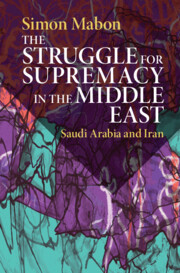
-
Select format
-
- Publisher:
- Cambridge University Press
- Publication date:
- March 2023
- March 2023
- ISBN:
- 9781108603690
- 9781108473361
- 9781108461443
- Dimensions:
- (229 x 152 mm)
- Weight & Pages:
- 0.61kg, 310 Pages
- Dimensions:
- (229 x 152 mm)
- Weight & Pages:
- 0.46kg, 310 Pages
You may already have access via personal or institutional login
Book description
Since 1979, few rivalries have affected Middle Eastern politics as much as the rivalry between Saudi Arabia and Iran. However, too often the rivalry has been framed purely in terms of 'proxy wars', sectarian difference or the associated conflicts that have broken out in Iraq, Lebanon, Syria, Bahrain, and Yemen. In this book, Simon Mabon presents a more nuanced assessment of the rivalry, outlining its history and demonstrating its impact across the Middle East. Highlighting the significance of local groups, Mabon shows how regional politics have shaped and been shaped by the rivalry. The book draws from social theory and the work of Pierre Bourdieu to challenge problematic assumptions about 'proxy wars', the role of religion, and sectarianism. Exploring the changing political landscape of the Middle East as a whole and the implications for regional and international security, Mabon paints a complex picture of this frequently discussed but oft-misunderstood rivalry.
Reviews
‘Challenging simplistic accounts of the rivalry between Saudi Arabia and Iran, Mabon highlights the multi-layered nature of the competition and offers a systematic account of its impact across the region. With flowing prose, personal accounts and conceptual engagement with theory, Mabon presents a thoughtful, nuanced must-read for anyone trying to make sense of the Middle East.’
Shahram Akbarzadeh - Deakin University
‘This is a valuable addition to the analysis of the Saudi-Iranian rift, reminding us of how complex it really is. Policymakers would do well to absorb the detailed look at the impact of the rivalry on neighbouring states to appreciate fully the nuances necessary to shape the parameters of any future resolution. Thought-provoking and well-informed.’
Rt Hon Alistair Burt - Former U.K. Minister for the Middle East
‘This book brings a fresh perspective to the competition which has structured so much of Middle Eastern regional politics over the last few decades. Applying novel theoretical insights and a wealth of empirical evidence, Mabon moves beyond a simplistic analysis of sectarianism to show how the rivalry interacts across levels of analysis in ways which give deeper social meanings to geopolitical competition.’
Marc Lynch - The George Washington University
‘Rejecting reductive ‘proxy war’ analyses, this book deftly illustrates how Iran and Saudi Arabia pursue rival visions of political order by building material and normative relationships with local actors, organizations, and groups. Mabon’s account recognizes the mutuality of these relationships and offers readers essential insight into conflict dynamics in the MENA region.’
Stacey Philbrick Yadav - Hobart and William Smith Colleges
‘Recommended.’
P. Clawson Source: Choice
‘The book emphasizes the importance of the struggle around aesthetic ideology in shaping the country’s state, society, and culture over the last half-century. The book is the winner of the 2022 Syrian Studies Association Best Book Prize. For readers who are interested in the intersection between culture and politics in the context of Syria and the Middle East, this book is a must-read.’
Chaoqun Lian Source: China International Strategy Review
‘[A] valuable contribution to the literature about Saudi-Iranian rivalry and sectarian politics in several Arab states.’
Gregory Aftandilian Source: Middle East Journal
Contents
Metrics
Altmetric attention score
Full text views
Full text views help Loading metrics...
Loading metrics...
* Views captured on Cambridge Core between #date#. This data will be updated every 24 hours.
Usage data cannot currently be displayed.
Accessibility standard: Unknown
Why this information is here
This section outlines the accessibility features of this content - including support for screen readers, full keyboard navigation and high-contrast display options. This may not be relevant for you.
Accessibility Information
Accessibility compliance for the PDF of this book is currently unknown and may be updated in the future.


